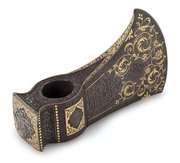
1727
Museum of Islamic Art
Fly whisks were traditionally used to swat away summer flies, and have been used as emblems of royalty in India since the 2nd century BCE. Seen in both sculptures and paintings flanking deities and rulers, they later appear in court scenes of the Mughal period, often held by attendants. This fly whisk is made of banded agate (onyx), and a cup fashioned from carnelian with emeralds set around the rim. A steel rod joins the shaft and cup. Originally a yak or horsetail plum, now missing, would have fitted into this handle. Given the fly whisk's small and delicate size, it was probably carried as an indication of status rather than being used by an attendant for active fanning.